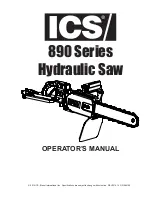
21
NOTICE
:
These instruction are for rough tensioning only. The only way to accurately tension the
blade is with a blade tension. Premature blade breakage is often caused by improper blade
tensioning.
Replacing conveyor
To replace the conveyor belts
:
1. Start the conveyor belt and stop it when the conveyor belt seam is accessible.
2. Disconnect the resaw from the power source!
3. Loosen the roller bracket by turning the roller bracket cap screws 3⁄4 of a turn.
4. Loosen the rear adjustment nuts away from the bracket plate.
5. Mark the front adjustment nut with a felt-tipped pen or a piece of tape, and thread the front adjustment
nut all the way up, while keeping track of the number of full turns that you moved the nut.
Note
:
Write the number of turns down, so you do not forget. Remembering this number is an important
part of the re-assembly process.
6. Slide the roller brackets toward the body of the re-saw to loosen the belt.
7. Remove the stiff cable from the center of the seam to separate the conveyor belt.
8. Remove the old conveyor belt from the conveyor table, and install the new conveyor belt in its place.
9. Mesh the seam “teeth” together on the new belt, and insert the stiff cable into the center of the seam to
lock it together.
10. Slide the roller brackets away from the body of the re-saw to tighten the belt.
11. Thread the front adjustment bolts the same number of turns as in step 5.
Note
:
The new belt may be tighter than the old one because it has not been broken-in. If this is the case,
deduct one or two turns from your original number of turns.











































